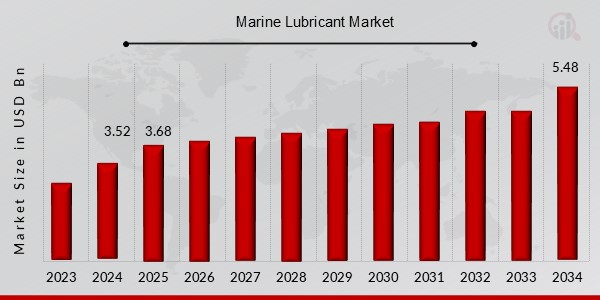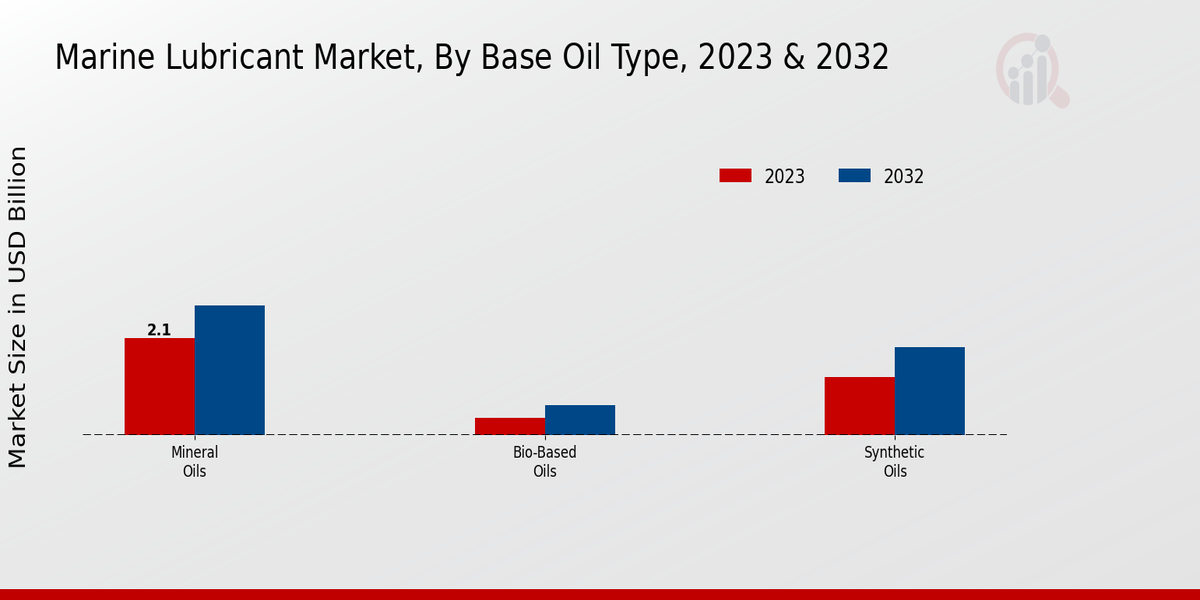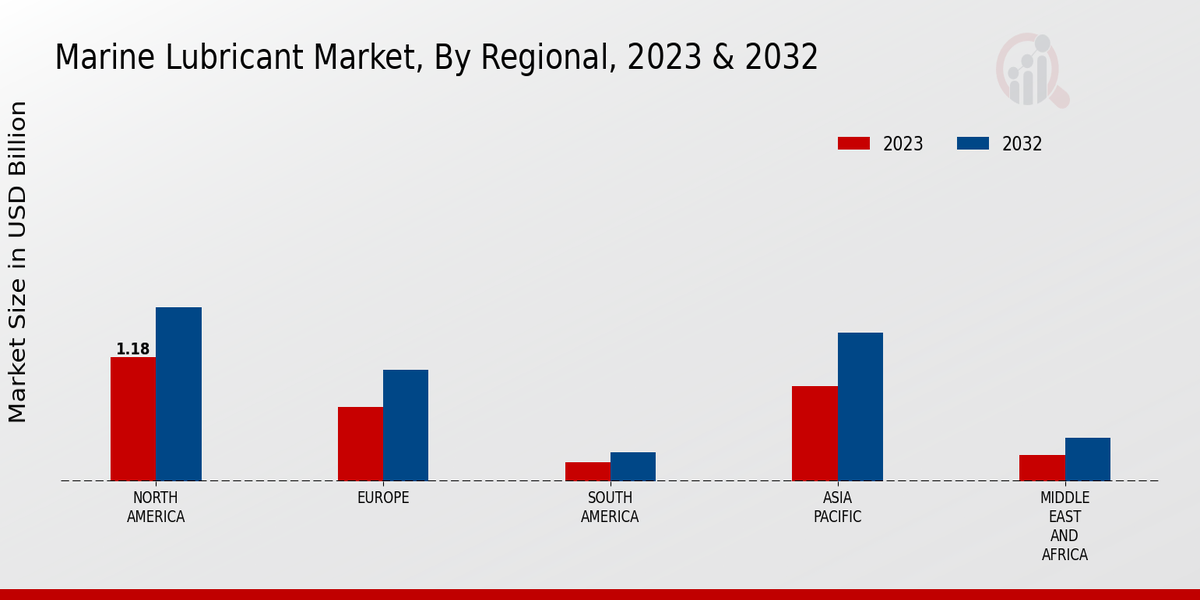Global Marine Lubricant Market Overview
Marine Lubricant Market Size was estimated at 3.52 (USD Billion) in 2024. The Marine Lubricant Industry is expected to grow from 3.68 (USD Billion) in 2025 to 5.48 (USD Billion) by 2034. The Marine Lubricant Market CAGR (growth rate) is expected to be around 4.53% during the forecast period (2025 - 2034).
Key Marine Lubricant Market Trends Highlighted
Emerging trends in the Marine Lubricant Market include increased adoption of bio-based and environmentally friendly lubricants, driven by regulations and growing environmental consciousness. Advances in engine technologies, such as two-stroke and four-stroke engines, demand specialized lubricants, creating new opportunities. The market is also influenced by the rise of digitalization, with remote monitoring and predictive maintenance solutions gaining traction. The focus on fuel efficiency and emissions reduction is driving demand for lubricants that optimize engine performance and reduce fuel consumption. Collaboration between lubricant manufacturers and ship owners is crucial for developing tailored solutions that meet specific operational needs. Additionally, the industry is witnessing the emergence of advanced lubricant formulations designed to withstand extreme conditions, ensuring the smooth operation of marine equipment and extending its lifespan.

Source Primary Research, Secondary Research, MRFR Database and Analyst Review
Marine Lubricant Market Drivers
Growing Demand for Environmentally Friendly Lubricants
The increasing recognition of the environmental hazards of marine operations, environmentally friendly lubricants have become extremely popular. These lubricants cause minimal effect on the environment both during their use and when they are disposed of. Usually, they are biodegradable and have a low toxicity level. In the forecast period, the fast growth of its utilization must be one of the key growth drivers in the Marine Lubricant Market Industry.
Expansion of the Shipping Industry
The growth of the shipping industry is expected to be a major driver of demand for marine lubricants. As the volume of goods transported by sea continues to increase, so too will the demand for lubricants to keep ships running smoothly. The expansion of the shipping industry is particularly strong in emerging markets, where the demand for imported goods is growing rapidly.
Technological Advancements in Marine Lubricants
Technological advancements are also expected to drive growth in the Marine Lubricant Market Industry. These advancements include the development of new lubricants that are more efficient, longer lasting, and better able to withstand the harsh conditions of the marine environment. The adoption of these new lubricants is expected to improve the performance and reliability of ships, which will in turn lead to increased demand for marine lubricants.
Marine Lubricant Market Segment Insights
Marine Lubricant Market Base Oil Type Insights
The Marine Lubricant Market is segmented by base oil type into mineral oils, synthetic oils, and bio-based oils. Among these, mineral oils held the largest market share in 2023, accounting for over 60% of the revenue. This is primarily due to their low cost and wide availability. However, synthetic oils are expected to witness the highest growth rate during the forecast period, owing to their superior performance characteristics, such as high viscosity index, low volatility, and excellent oxidation stability. Bio-based oils are also gaining traction in the market, as they offer environmental benefits and are biodegradable.
The marine lubricant market is driven by the growth in the shipping industry. The increasing demand for marine lubricants is primarily attributed to the rising number of vessels, particularly in the Asia-Pacific region. Additionally, the growing awareness of the importance of using high-quality lubricants to ensure the efficient operation of marine engines is contributing to the market growth. The market is expected to witness steady growth over the coming years, driven by the increasing demand for marine lubricants from the shipping industry.

Source Primary Research, Secondary Research, MRFR Database and Analyst Review
Marine Lubricant Market Application Insights
The segmentation of the marine lubricant market by application includes engine oils, gear oils, hydraulic oils, and greases. The largest share of the segment belongs to engine oils because they are most commonly used in marine engines of all constructive types of ships. The demand for them remains at a high level because of the growing marine sector and the expansion of the ship fleet in the future years. The second largest segment, gear oils, are required by the gearboxes and transmissions of ships of all sizes operating around the world.
Hydraulic oils, which are utilized in the hydraulic systems to transfer power and control mechanisms, are also an integral part of the leading segments of the market. Greases used for the lubrication of ships’ components, like bearings, seals, or open gears will likely experience growth in the future.
Marine Lubricant Market Vessel Type Insights
The Marine Lubricant Market is segmented by vessel type into commercial vessels, passenger vessels, military vessels, and recreational vessels. Commercial vessels account for the largest share of the market, due to the high demand for marine lubricants in the shipping industry. Passenger vessels are the second largest segment, driven by the growing cruise industry. Military vessels are also a significant segment, as they require specialized lubricants that can withstand harsh conditions. Recreational vessels are the smallest segment, but are expected to grow in the coming years due to the increasing popularity of boating.
In 2023, the Marine Lubricant Market for commercial vessels was valued at USD 1.2 billion and is projected to grow to USD 1.6 billion by 2030, exhibiting a CAGR of 4.5% during the forecast period. The market for passenger vessels is expected to grow from USD 0.8 billion in 2023 to USD 1.1 billion by 2030, with a CAGR of 4.8%. The military vessels segment is expected to grow from USD 0.6 billion in 2023 to USD 0.8 billion by 2030, with a CAGR of 4.2%. The recreational vessels segment is expected to grow from USD 0.4 billion in 2023 to USD 0.6 billion by 2030, with a CAGR of 4.9%.
The key factors driving the growth of the Marine Lubricant Market include the increasing demand for marine lubricants in the shipping industry, the growing cruise industry, and the increasing popularity of boating. The market is also expected to benefit from the development of new and innovative marine lubricants that can meet the specific needs of different vessel types.
Marine Lubricant Market Performance Characteristics Insights
The Performance Characteristics segment of the Marine Lubricant Market is a crucial aspect, contributing significantly to the overall industry growth. Anti-wear additives, with a market value exceeding USD 1 billion in 2023, play a vital role in reducing wear and tear on critical engine components, extending equipment life and minimizing maintenance costs. Anti-corrosion additives, valued at over USD 900 million in 2023, protect metal surfaces from rust and corrosion, ensuring optimal performance and longevity of marine machinery. Anti-oxidation additives, with a market size of approximately USD 800 million in 2023, combat the harmful effects of oxidation, safeguarding lubricants from degradation and extending their lifespan.
Detergency additives, valued at around USD 750 million in 2023, effectively remove contaminants and deposits, maintaining cleanliness and preventing equipment malfunction. Dispersancy additives, with a market worth of over USD 650 million in 2023, ensure contaminants remain suspended in the lubricant, preventing agglomeration and potential damage to machinery. These performance characteristics are essential for the efficient and reliable operation of marine vessels, driving demand for marine lubricants across various segments of the industry.
Marine Lubricant Market Additives Insights
Additives segment is expected to witness significant growth in the Marine Lubricant Market during the forecast period. The growth of this segment can be attributed to the increasing demand for high-performance marine lubricants that can withstand extreme conditions. Additives play a crucial role in enhancing the performance of marine lubricants by improving their anti-wear, anti-corrosion, and anti-foaming properties. Anti-foaming agents prevent the formation of foam in marine lubricants, which can lead to reduced lubrication efficiency and equipment damage.
Anti-scuffing agents minimize metal-to-metal contact, thereby reducing wear and tear on critical components. Viscosity index improvers maintain the viscosity of marine lubricants over a wide temperature range, ensuring optimal lubrication under varying operating conditions. Corrosion inhibitors protect metal surfaces from corrosion, extending the lifespan of marine equipment. Detergents keep marine lubricants clean by removing contaminants and preventing the formation of deposits. The increasing adoption of high-performance marine lubricants in the shipping and offshore industries is driving the growth of the additives segment.
The demand for marine lubricants with extended drain intervals, improved fuel efficiency, and reduced emissions is also contributing to the growth of this segment. The Asia-Pacific region is expected to witness the highest growth in the additives segment due to the increasing demand for marine lubricants in the region's rapidly expanding shipping and offshore industries.
Marine Lubricant Market Regional Insights
The regional segmentation of the Marine Lubricant Market offers valuable insights into the geographical distribution of market size and growth potential. North America held a significant market share in 2023, valued at 1.178 billion USD, and is projected to maintain its dominance throughout the forecast period, with a value of 1.653 billion USD in 2032. The region's advanced shipbuilding industry and robust maritime trade activities contribute to the high demand for marine lubricants. Europe is another key market, valued at 0.703 billion USD in 2023 and projected to reach 1.057 billion USD by 2032, driven by stringent environmental regulations and a growing focus on energy efficiency in the marine sector.
The Asia-Pacific (APAC) region is expected to exhibit the highest growth rate during the forecast period, with values of 0.907 billion USD in 2023 and 1.411 billion USD in 2032, owing to the expanding shipbuilding and shipping industries in countries like China, India, and South Korea. South America and the Middle East Africa (MEA) regions also present growth opportunities, with South America valued at 0.183 billion USD in 2023 and projected to reach 0.272 billion USD by 2032, while MEA is valued at 0.249 billion USD in 2023 and expected to reach 0.408 billion USD by 2032, with increasing investments in offshore exploration and production activities. Understanding the regional market dynamics is crucial for businesses to tailor their strategies and target specific geographies for growth.

Source Primary Research, Secondary Research, MRFR Database and Analyst Review
Marine Lubricant Market Key Players And Competitive Insights
Driving innovation in the Marine Lubricant Market industry, major players are actively involved in expanding their product portfolios. In May 2022, Chevron Corporation introduced its new marine cylinder oil under the Delo brand. Today, the leaders of the Marine Lubricant Market are also promoting their perspectives through partnerships. For example, in November 2021, Shell Marine and Daewoo Shipbuilding Marine Engineering signed a Memorandum of Understanding intending to collaborate in the area of developing next-generation marine lubricants. Thus, increasing investments in the shipping industry and rising demand for marine lubricants in emerging economies will drive the development of the Marine Lubricant Market. The growth of the cruise and tourism industry will also contribute to this trend. New technological solutions, such as automated systems for lubricating mechanical parts and measuring devices, create new growth opportunities for the Marine Lubricant Market.
Shell Marine is the leader of the Marine Lubricant Market industry. The company supplies various types of marine lubricants, including engine oils, gear oils, and hydraulic oils. Shell serves customers in more than 100 countries around the world. At the heart of the company’s development is a responsible approach to the production of the products and the implementation of innovation that meets the most stringent safety and environmental requirements. A significant role in the success of Shell Marine belongs to the RD team of specialists who are responsible for product development and technology implementation.
Castrol Marine is the leader’s main competitor in the Marine Lubricant Market. The company is also engaged in the production of various types of marine lubricants, including engine oils, gear oils, and hydraulic oils. The company operates in more than 50 countries and is known for its focus on high quality products and the high level of customer services. Castrol considers exclusive technologies to be the foundation of its development.
Key Companies in the Marine Lubricant Market Include
-
LUKOIL
-
FUCHS
-
Chevron
-
Castrol
-
Total
-
Repsol
-
ExxonMobil
-
Phillips 66
-
Shell
-
Petronas
-
Sinopec
-
Mobil
-
BP
-
Valvoline
-
TotalEnergies
Marine Lubricant Market Industry Developments
The increasing demand for efficient and eco-friendly lubricants in the marine industry is driving the market growth. Stricter environmental regulations and the adoption of low-emission vessels are expected to further propel the demand for marine lubricants.
Recent developments in the market include the launch of new products, such as biodegradable and synthetic lubricants, by major players like Chevron, Shell, and ExxonMobil. Strategic partnerships and acquisitions are also shaping the market landscape. For instance, in 2023, Chevron acquired the marine lubricant business of TotalEnergies, expanding its footprint. Key market players are focusing on developing innovative lubricants that meet the specific requirements of modern marine engines and equipment.
Marine Lubricant Market Segmentation Insights
Marine Lubricant Market Base Oil Type Outlook
Mineral Oils
Synthetic Oils
Bio-Based Oils
Marine Lubricant Market Application Outlook
Engine Oils
Gear Oils
Hydraulic Oils
Greases
Marine Lubricant Market Vessel Type Outlook
Commercial Vessels
Passenger Vessels
Military Vessels
Recreational Vessels
Marine Lubricant Market Performance Characteristics Outlook
Anti-wear
Anti-corrosion
Anti-oxidation
Detergency
Dispersancy
Marine Lubricant Market Additives Outlook
Anti-foaming Agents
Anti-scuffing Agents
Viscosity Index Improvers
Corrosion Inhibitors
Detergents
Marine Lubricant Market Regional Outlook
North America
Europe
South America
Asia Pacific
Middle East and Africa
| Report Attribute/Metric |
Details |
| Market Size 2024 |
3.52 (USD Billion) |
| Market Size 2025 |
3.68 (USD Billion) |
| Market Size 2034 |
5.48 (USD Billion) |
| Compound Annual Growth Rate (CAGR) |
4.53% (2025 - 2034) |
| Report Coverage |
Revenue Forecast, Competitive Landscape, Growth Factors, and Trends |
| Base Year |
2024 |
| Market Forecast Period |
2025 - 2034 |
| Historical Data |
2020 - 2024 |
| Market Forecast Units |
USD Billion |
| Key Companies Profiled |
LUKOIL, FUCHS, Chevron, Castrol, Total, Repsol, ExxonMobil, Phillips 66, Shell, Petronas, Sinopec, Mobil, BP, Valvoline, TotalEnergies |
| Segments Covered |
Base Oil Type, Application, Vessel Type, Performance Characteristics, Additives, Regional |
| Key Market Opportunities |
Rising demand for fuel efficient lubricants Increasing adoption of biodegradable lubricants Technological advancements in lubricant formulations |
| Key Market Dynamics |
Rising fuel prices Increasing demand for high quality lubricants Growing awareness of environmental regulations Adoption of new engine technologies Expanding ship fleet size |
| Countries Covered |
North America, Europe, APAC, South America, MEA |
Frequently Asked Questions (FAQ) :
The Marine Lubricant Market is projected to reach approximately 5.48 USD Billion by 2034.
The Marine Lubricant Market is estimated to grow at a healthy CAGR of 4.53% during the forecast period.
The primary application segment in the Marine Lubricant Market is the propulsion engines segment.
Key players in the Marine Lubricant Market include Chevron, Shell, ExxonMobil, BP, and TotalEnergies.
The Marine Lubricant Market is projected to expand at a CAGR of approximately 5.2% in the Asia-Pacific region during the forecast period.
The offshore exploration and production industry is expected to significantly drive the growth of the Marine Lubricant Market.
Stringent environmental regulations and the fluctuating prices of raw materials pose challenges to the Marine Lubricant Market.
The Marine Lubricant Market is segmented into various product types, including engine oils, gear oils, and hydraulic oils.
Technological advancements, such as the development of biodegradable lubricants, are positively influencing the growth of the Marine Lubricant Market.
















